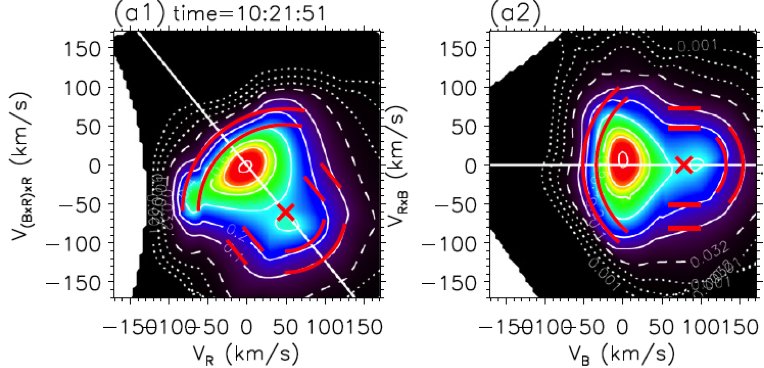行星际太阳风是如何加热的,以及太阳风湍流的串级是如何耗散的,是两个互相关联的科学难题。研究突破的难点,在于无法把太阳风动力学湍流的波模诊断和太阳风质子速度分布的分析结合起来。我们首次综合最新的波模诊断方式和最高时间分辨率的质子动力学特征,不仅印证了太阳风湍流在动力学尺度的二元波动特征,即准平行的离子回旋波和准垂直的动力论阿尔芬波,而且首次辨认出了离子回旋波与质子核成分回旋共振、动力论阿尔芬波朗道共振产生束流并回旋共振加热束流的扩散平台,从而提出关于太阳风动力学湍流的二元波动对质子的垂直加热和平行加热的图像。
该成果近期发表在 Astrophys. J. Lett. (ApJL)上 (He, J.-S., et al., ApJL, 800, L31, 2015)。 文章作者为:何建森、王玲华、涂传诒、Eckart Marsch、宗秋刚。 研究工作得到国家自然科学基金委创新群体、重点项目、优青项目、和面上项目的支持。
Jiansen He et al. 2015 ApJ 800 L31 doi:10.1088/2041-8205/800/2/L31
EVIDENCE OF LANDAU AND CYCLOTRON RESONANCE BETWEEN PROTONS AND KINETIC WAVES IN SOLAR WIND TURBULENCE
Jiansen He1, Linghua Wang1, Chuanyi Tu1, Eckart Marsch2, and Qiugang Zong1
1School of Earth and Space Sciences, Peking University, Beijing 100871, China 2 Institute for Experimental and Applied Physics, Christian-Albrechts-Universität zu Kiel, D-24118 Kiel, Germany

 The wave–particle interaction processes occurring in the solar wind provide crucial information to understand the wave dissipation and simultaneous particle heating in plasma turbulence. One requires observations of both wave fluctuations and particle kinetics near the dissipation range, which have, however, not yet been analyzed simultaneously. Here we show new evidence of wave–particle interactions by combining the diagnosis of wave modes with the analysis of particle kinetics on the basis of measurements from the WIND spacecraft with a high cadence of about 3 s. Solar wind protons appear to be highly dynamic in their velocity distribution consisting of varying anisotropic core and beam components. The basic scenario of solar wind proton heating through wave–particle interaction is suggested to be the following. Left-handed cyclotron resonance occurs continuously, and is evident from the observed proton core velocity distribution and the concurrent quasi-parallel left-handed Alfvén cyclotron waves. Landau and right-handed cyclotron resonances are persistent and indicated by the observed drifting anisotropic beam and the simultaneous quasi-perpendicular right-handed kinetic Alfvén waves in a general sense. The persistence of non-gyrotropic proton distributions may cast new light on the nature of the interaction between particles and waves near and beyond the proton gyro-frequency.
The wave–particle interaction processes occurring in the solar wind provide crucial information to understand the wave dissipation and simultaneous particle heating in plasma turbulence. One requires observations of both wave fluctuations and particle kinetics near the dissipation range, which have, however, not yet been analyzed simultaneously. Here we show new evidence of wave–particle interactions by combining the diagnosis of wave modes with the analysis of particle kinetics on the basis of measurements from the WIND spacecraft with a high cadence of about 3 s. Solar wind protons appear to be highly dynamic in their velocity distribution consisting of varying anisotropic core and beam components. The basic scenario of solar wind proton heating through wave–particle interaction is suggested to be the following. Left-handed cyclotron resonance occurs continuously, and is evident from the observed proton core velocity distribution and the concurrent quasi-parallel left-handed Alfvén cyclotron waves. Landau and right-handed cyclotron resonances are persistent and indicated by the observed drifting anisotropic beam and the simultaneous quasi-perpendicular right-handed kinetic Alfvén waves in a general sense. The persistence of non-gyrotropic proton distributions may cast new light on the nature of the interaction between particles and waves near and beyond the proton gyro-frequency.

